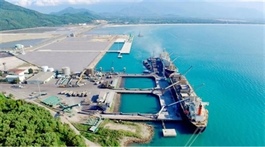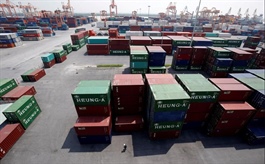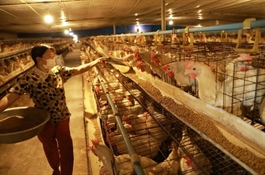Fishery sector seeks sustainable growth, aiming for $9.5 billion export value in 2024
Fishery sector seeks sustainable growth, aiming for $9.5 billion export value in 2024
Establishing production chains to enhance competitiveness and promote green production has become vital for the fishery industry to develop sustainably.

Seafood products are processed at Coastal Fisheries Development Corporation, HCM City. The fishery industry set the target for export revenue at $9.5 billion in 2024. — VNA/VNS Photo Hồng Đạt |
Trần Đình Luân, Director of the Việt Nam Directorate of Fisheries, said at a conference on Thursday that the industry aimed for an export revenue of US$9.5 billion in 2024 on low global consumption demand, with a total output of around 9.22 million tonnes, equivalent to this year. However, marine captures are expected to drop by 8.3 per cent to 3.54 million tonnes, while aquaculture would increase by 5 per cent to 5.68 million tonnes.
Luân pointed out that the fishery industry continued to face challenges, including declining seafood resources, the European Commission’s yellow-card warning and low demand in major export markets.
Along with enhancing linkages and establishing value chains, it was necessary to remove market difficulties for key products, reduce natural exploitation, increase aquaculture, and develop the seafood economy in a sustainable manner which is adaptable to climate change, he said.
“Production must be linked in chain. The origin of products must be traceable. Marine capture must be appropriate with reserves and ensure food safety during the process.”
The sector must also pay attention to reducing emissions and increasing green production, he said, adding that animal welfare is also an issue for aquaculture, which is not only a demand of the domestic market but also a trend in the global market.
According to Nhữ Văn Cẩn, Deputy Director of the Department of Aquaculture, the fishery industry is estimated to reach an output of 9.269 million tonnes this year, an increase of 2 per cent against 2022, of which, capture fisheries is 3.861 million tonnes and aquaculture, 5.408 million tonnes.
Việt Nam set the target of reducing capture fisheries output to 3.68 million tonnes.
The export revenue is estimated at $9.2 billion for the full year, or 92 per cent of the plan set for 2023 at $10 billion.
Major fisheries products included shrimp with an export value of $3.45 billion, tra fish $1.9 billion and tuna $900 million.
Dương Long Trì, Deputy General Secretary of Việt Nam Association of Seafood Exporters and Producers, said the output of major export seafood products such as shrimp and tra fish saw increases, but it would be difficult to maintain the increase in volume over time.
He cited figures that farmed shrimp output was about 1.1 million tonnes compared to the previous output of 700,000 tonnes, but the export value did not increase much, only about $3.5-4 billion.
This raised the need for increasing processing to push up added value for products and boost export value, he said.
Nguyễn Văn Trung, head of the Fishing Vessel and Fisheries Logistics Service Facility Management Department, said that it was necessary to improve the electronic diary software for tracing the origin of seafood products, together with increasing inspection to ensure compliance with regulations on exploitation.
Digitalising data would be an important solution to improve transparency and efficiency in the administration, Trung said.























